After creating the modern multi-purpose vehicle (MPV) market in 1983 with the launch of the Toyota Spacecruiser, Toyota sent further shockwaves through the industry with that vehicle’s futuristic replacement – the world’s first mid-engined MPV, the Toyota Previa.
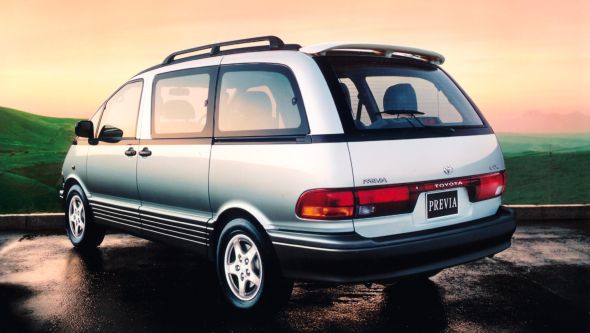
Designed by Tokuo Fukuichi, now global head of sister brand Lexus, the Previa was launched in the UK in September 1990 at the International Motor Show in Birmingham. The name Previa* was derived from the Italian word previdenza, which means providence or foresight. The relevance of that name became clear on its unveiling as its inventive, oval shape informed the appearance of a new breed of MPVs.
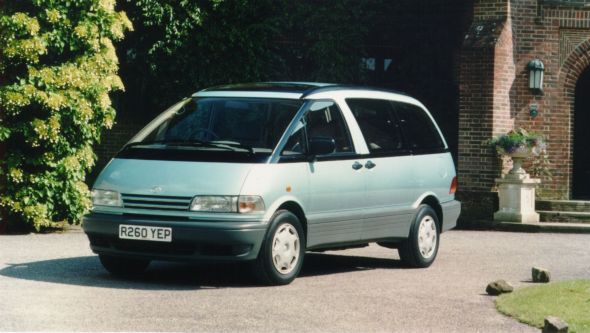
But the really clever part of Previa was its novel engine installation. Canted on its side and mounted at a 75 degree angle, the 133bhp 2.4-litre 16v twin-cam fuel injected unit sat under the floor behind the front axle line powering the rear wheels. This enabled Toyota’s engineers to optimise weight distribution, ensure a low centre of gravity and provide a flat floor space inside upon which to mount the seats. All ancillary equipment and fluid reservoirs were installed under the bonnet for easy access, however the substantial engineering of this Supplemental Accessory Drive System meant the TZ-series petrol engine remained unique to Previa**.
Meanwhile, a sliding side door and large rear hatch meant easy access in and out of the vehicle, and a low lip ensured luggage was easy to load. Ample accommodation for eight people was available in a 2/3/3 seating configuration, with the third row also able to split and fold away for increased luggage capacity.
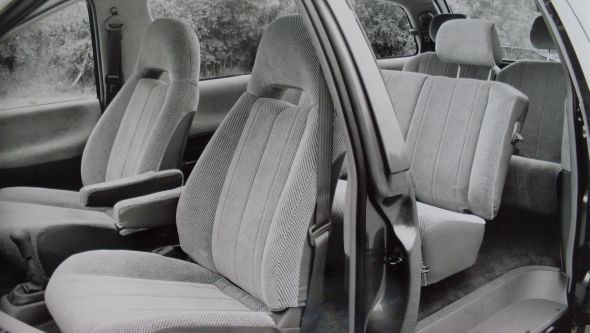
Launched in the UK in just one GL derivative (the Japanese market included two additional versions named Estima Lucida and Estima Emina that were narrower and shorter to exploit tax laws), Previa was nevertheless well-equipped. Highlights included a choice of five-speed manual or four-speed automatic transmissions, twin sunroofs, anti-lock brakes, six-speaker audio and speed-sensitive power-assisted steering.
See also:
History of the Toyota Hilux
History of the Toyota Land Cruiser (Station Wagon models)
History of the Toyota Land Cruiser (Heavy and Light duty models)
History of the Toyota MR2
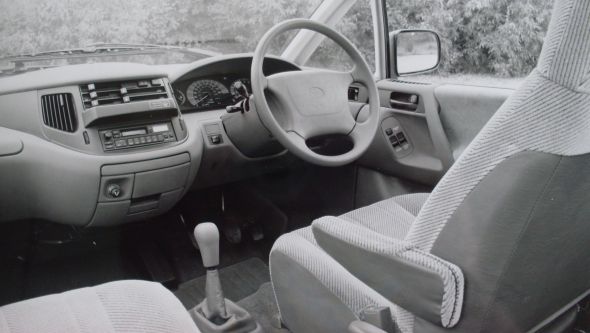
Variety increased from October 1993 onwards, when a high-specification seven-seat GX model was launched with individual captain’s seats in the middle row, alloy wheels, roof rails and cruise control. At the same time, Previa also underwent a subtle revision primarily focused on improving its aerodynamics. The launch version had a drag co-efficient value of 0.35, but by altering the windscreen wiper design and fitting a rear spoiler this value was reduced to 0.32.
A base GS model joined a consolidated range in March 1995. It lost the anti-lock brakes and twin sunroof setup that remained on the GL and GX but also became the only UK version available with a choice of manual or automatic gearbox. Special edition Solair and Motiv-8 models arrived in July 1995 and February 1996 respectively, the former improving on the already high-spec GX model and the latter restoring much of the GL specification to the GS grade. The GS blossomed again into the Solair special edition in March 1996, equipping the base grade with two unique paint options and the GX’s seven-seat layout.
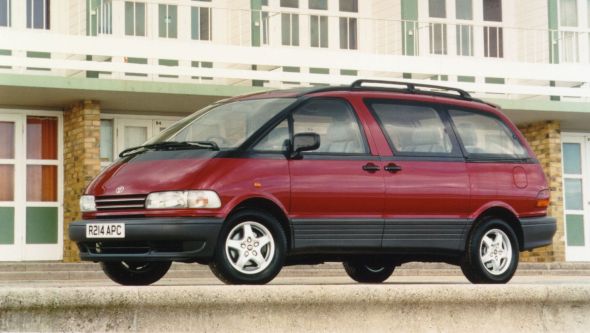
See also:
History of the Toyota Prius
History of the Toyota RAV4
History of the Toyota Supra
At this point in Previa production both outer seats in the middle row were fitted with three-point seat belts and a driver’s airbag had become a standard fixture on GL models and upwards. From October 1996, the engine was retuned to improve fuel economy and meet the latest emission requirements, though the power and torque figures remained identical.
Minor improvements carried out towards the end of Previa’s life cycle included the fitment of twin airbags, pre-tensioned front seat belts and a high-mounted third brake light. Finally, in January 1997, the limited edition Liber-8 model (400 in total) was launched as the model’s final hurrah. Once again based on the GS, this eight-seat model was immediately identified by its colour-coded side cladding.
ALL-NEW NEXT-GENERATION MODEL
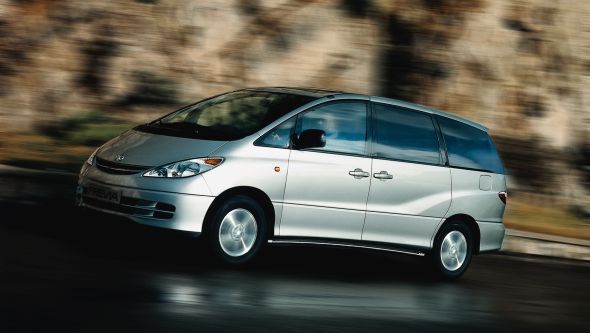
Just as the first-generation Previa caught the MPV world napping, so the second-generation model advanced the segment with its sharpened ‘one wave’ design and class-leading space-efficiency.
Debuted at the 2000 Geneva Motor Show and launched in the UK on 5 July the same year, new Previa was a clean-sheet project that reworked the original car’s packaging for a more car-like driving experience and increased interior space despite some marginally smaller proportions. Now front-engine and front-wheel drive, the car was initially available with one engine option, two gearboxes, three trim levels and a choice of seven- or eight-seat configurations.
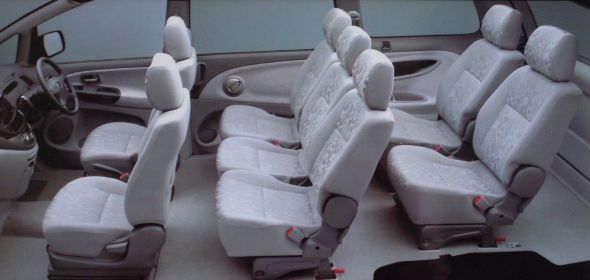
Power came from an all-new 2.4-litre AZ-series VVT-i engine shared with a number of other Toyota models available throughout the world. Producing 156PS at 5,600rpm and 166 lb/ft at 4,000rpm, it represented a useful power advantage over the previous model, while improved aerodynamics (now down to Cd 0.29) and a lower kerb weight helped the latest Previa deliver an unmatched combination of economy and performance.
Without needing to accommodate a propshaft, new Previa was designed with a lower, flatter floor. Not only did this improve luggage capacity and headroom, especially in the rear, but it was achieved with a lower roof height too. The seat hip points were 40-50mm lower, meaning that it was easier for the very young or very old to enter and exit the car; and they could now do so via sliding doors on either side.

Flexibility and interior functionality were similarly improved. The individual seats on the seven-seat model could slide, tumble and fold or be detached entirely, potentially turning the Previa into a two-seat vehicle with an enormous, van-like load capacity. In the eight-seat model, the second row bench could split 60:40 and had a reclining back, while the third row bench tipped to create extra luggage space. Also dotted around the cabin were 18 different cubbie holes, individual overhead lights and air vents for six passengers.
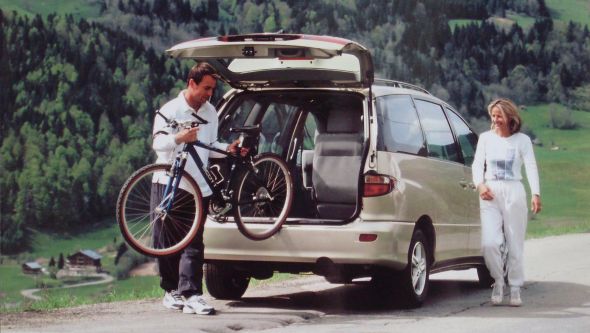
Class-leading safety features were integrated into new Toyota Previa from the outset. Anti-lock brakes and electronic brake force distribution was standard across all models, while the brake pedal itself was designed to retreat away from the driver in the event of an accident to reduce the risk of lower leg injury. Airbags were fitted for both driver and front seat passenger, and the front seat belts contained pretensioners and force limiters.
Ergonomics were updated and improved by angling the instrument panel towards the driver and slightly higher towards the centre in order to reduce line of sight movement. The main displays featured Optitron lighting to project a clear, high-contrast analogue image that was both stylish and easy to read.
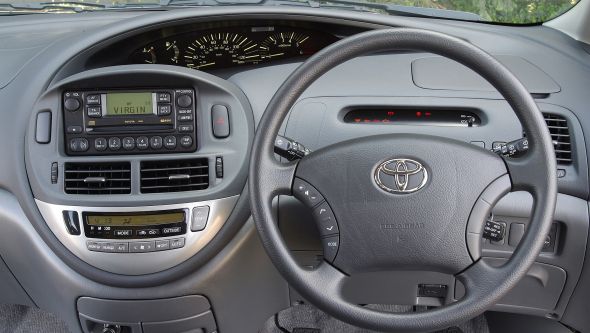
Similar to the trim levels of the outgoing model, new Toyota Previa was available from launch in either GS, GLS or CDX grades (later changed to T2, T3 and T Spirit as part of a streamlined grade structure). The base model was initially only available as an eight-seater with a choice of manual or automatic gearboxes, while the auto-only CDX could only be specified with a seven-seat configuration. Mid-range GLS was also mated to an automatic gearbox but you could chose between a seven- or eight-seat configuration at no extra charge.
See also:
History of the Toyota Starlet
History of the Toyota Yaris
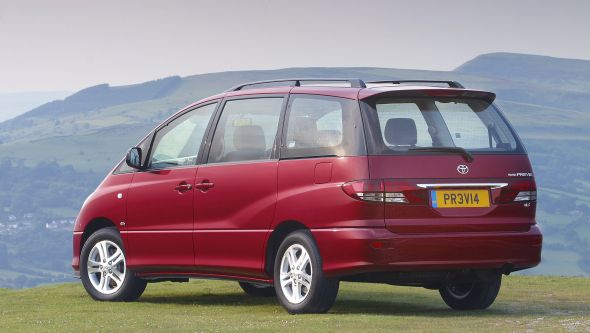
Thanks to its more traditional engine layout, engine options for the UK market*** were increased with the availability of a 2.0-litre D-4D turbo diesel alternative midway through 2001. Tuned specifically for this application, Toyota’s acclaimed common rail, direct injection unit offered 114bhp and a flat torque curve that spread all the way from 1,800 to 3,000rpm for relaxed driving. Available in each trim grade, it was only mated to a manual gearbox.
In the mid-Noughties, the market that catapulted Previa into the limelight had changed. Rising popularity of smaller MPVs such as the Toyota Verso models and lifestyle-oriented SUV models like the RAV4 slowed sales until the Toyota Previa was deleted from the European line-up in 2005. A third-generation model arrived in other markets in 2006.
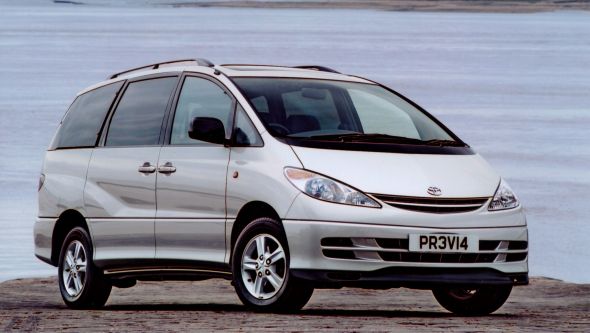
TOYOTA PREVIA DIMENSIONS
First generation: 4,750mm (length), 1,800mm (width), 1,780mm (height), 2,860mm (wheelbase)
Second generation: 4,750mm (length), 1,790mm (width), 1,770mm (height), 2,900mm (wheelbase)
* Toyota Previa was also known as Estima, Canarado and Tarago in other markets
** Engine options available in other markets were a supercharged 2.4-litre TZ-series petrol and 2.2-litre C-series turbo diesel. Four-wheel drive models were also available in other markets
*** Domestic market Estima models were available with a 3.0-litre MZ-series V6 petrol engine and four-wheel drive. A hybrid version (claimed to be the world’s first hybrid MPV) joined the Japanese line-up in June 2001
See also:
History of the Toyota 2000GT
History of the Toyota Camry
History of the Toyota Carina
History of the Toyota Celica
History of Toyota’s compact MPV models
History of the Toyota Corolla
History of the Toyota Hilux
History of the Toyota Land Cruiser (Station Wagon models)
History of the Toyota Land Cruiser (Heavy and Light duty models)
History of the Toyota MR2
History of the Toyota Prius
History of the Toyota RAV4
History of the Toyota Sports 800
History of the Toyota Supra
History of the Toyota Starlet
History of the Toyota Yaris
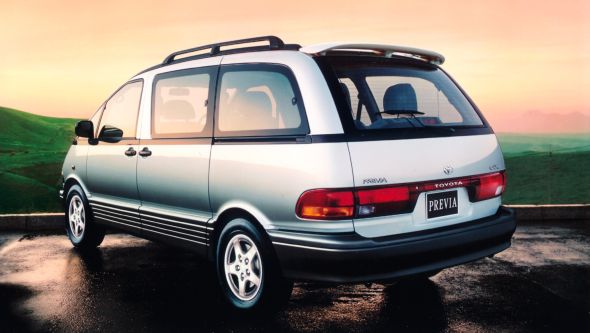
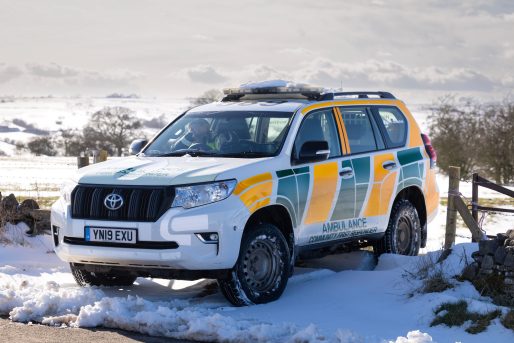
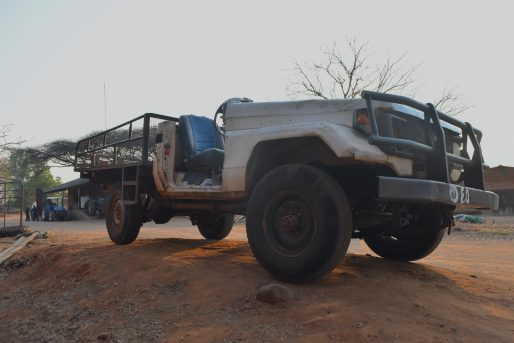

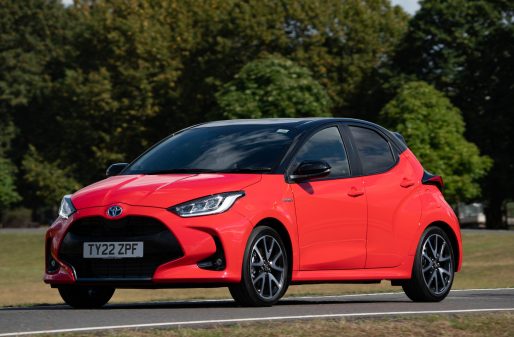
Hi. I’m thinking of buying a toyota previa 2004 model.
It has around 138000 miles on it.
Do you think the mileage is to hi or it can run for some more years.
Hi Paul, thanks for your comment.
You should be able to enjoy many more miles from that Previa, just make sure that it has a good service history.
Thanks
why is so difficult to find any items for the Toyota previa/estima in the UK, I find more info in the AU & NZ sites about this vehicle?
We had the second generation of this vehicle, it was my children changing room when we took them on athletic competition around UK, holiday in France,Ireland,Italy, UK.
Now proud owners of a Estima Areas Hybrid van, but the usual company for parts, Toyota main dealer in Sunderland, Durham, Newcastle not very helpful when we ask for parts from bulb to simple roof rack, not to mention the awful Halfords shop main dealer for Thule items.
They insisted I could not have any roof bars or rack for our van, then contacted our helpful corner automotive parts shop which put us on EBAY and found the original new individual Thule parts Kit 1384 , Thule Feet part 754 and reused the old bars from the Estima Emina G-lux van.
Now we can go on holiday thanks for making such art work of a van and hope in the near future Toyota will produce something similar for the large family.
Still looking for Roof Side Bars for this Vehicle any suggestions?
thank you Ennio
Hi Ennio,
Estima Areas Hybrid was never sold in Europe, so it is an imported vehicle. We don’t have information or support for vehicles like this and can’t advise on part suitability. Sorry about that.
Thanks
Need to buy
Hi , What year did the Toyota previa stop the reserve oil resovoir. Thanks
Hi Steve,
Thanks for your comment.
From the information that we have, it doesn’t look like this vehicle and engine combination was available in the UK, so unfortunately we are unable to answer the question.
However, if you have a specific vehicle that you would like us to check, please provide us with the UK registration.
Thanks.
Hi, the previa in questions reg is T697LLC . Thanks
Hi Steve,
Thanks for your reply.
Due to the age of your vehicle, we unfortunately don’t have detailed information to give, but from the information we can see in the parts catalogue, it appears to advise that this vehicle does not have the reservoir.
Thanks.
Last night I think my Previa breaks broke for the last time and I am absolutely gutted that my wonderful car may have to be scrapped because she’s getting too expensive to fix now.
She has run like a beast for 25yrs or so and I still get random people high fiving me when they see me in her or stopping me in the street to tell me about the fun they had in theirs.
This is the third one I’ve owned over the last 15yrs because any other car I look at just isn’t as perfect for me to explore the world in.
I love the versatility of being able to take friends and anything we like with us and put the seats down to make a bed if needed. The way the seats move is great and I love the dual sun roof along with the reliability and everything else!
I have driven all over the UK and every year, before corona, I would drive to France, Netherlands, Germany Spain, Portugal, Croatia Austria and even Hungary to go to festivals and enjoy exploring Europe.
I’m going to be genuinely heartbroken when I don’t have this car anymore, it’s so sad it’s not made any more.
Thanks for creating such a fun and reliably perfect car, I thoroughly enjoyed it while it lasted, as many people did!
Hi Heather, thanks for your comment.
It’s great to hear that you have such fond memories with your Previa. It’s a shame to see her on her last legs!
Any ideas on what you will go for next?
Thanks
I actually think that Toyota should bring back the Previa to the Uk because the imported models are so popular especially in Birmingham
Is there anyway to see a specific brochure on the Toyota previa? I was once included in one where the car was being shown at Woburn safari park and I would love to be able to see it.
What do you think of me buying a 1995 toyota previa with only about 80k mileage?
Is it likely to be problematic and expensive on repairs or will have a life left in still?
Apparently only one owner from new based on vehicle listing.
Hi, thanks for your question.
We cannot comment on this since it would require a physical inspection to determine the condition of the vehicle. We suggest having a look at our Toyota Used and Approved Vehicles here – https://www.toyota.co.uk/used-cars.
Thanks.
OK so please can you inspect it for me what would be the cost?
Hi,
Please contact a Toyota Centre regarding this. You can find your nearest dealer here – https://www.toyota.co.uk/find-a-dealer.
Thanks.
How can I stop a water leak in both corners to the joining front pillars when I move off I suddenly get a soaking as water jets out of the top of trim and roof liner
Hi Bob, thanks for your question.
We are sorry to hear this. Please contact your Toyota Centre regarding this.
Thanks.
I am thinking about a Toyota Previa but need to know if I can get a wheelchair in behind the rear seats as I need all 7 seats in use. Can you help, please?
Hi Robert,
Thanks for your question.
We would recommend viewing the vehicle in-person to see if it is suitable for your needs.
Thanks.